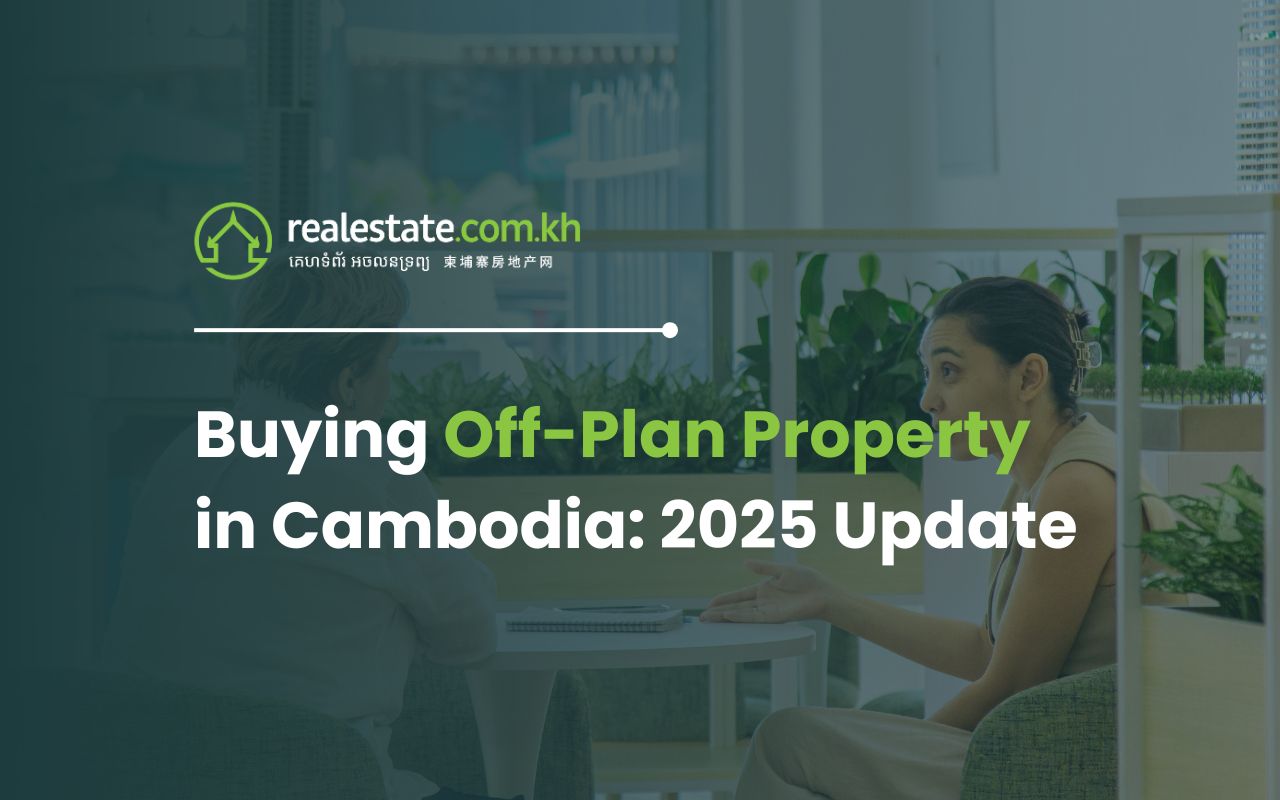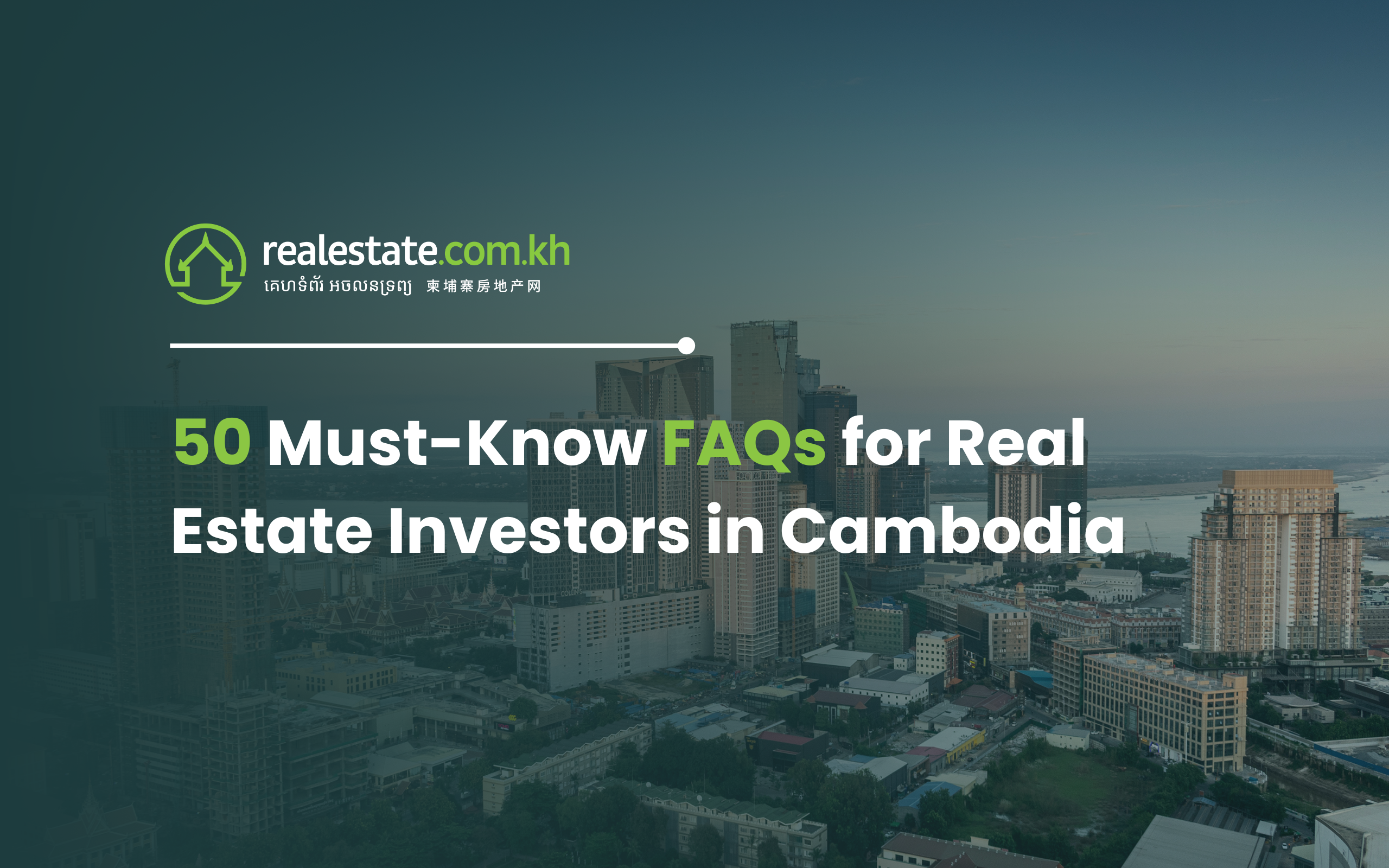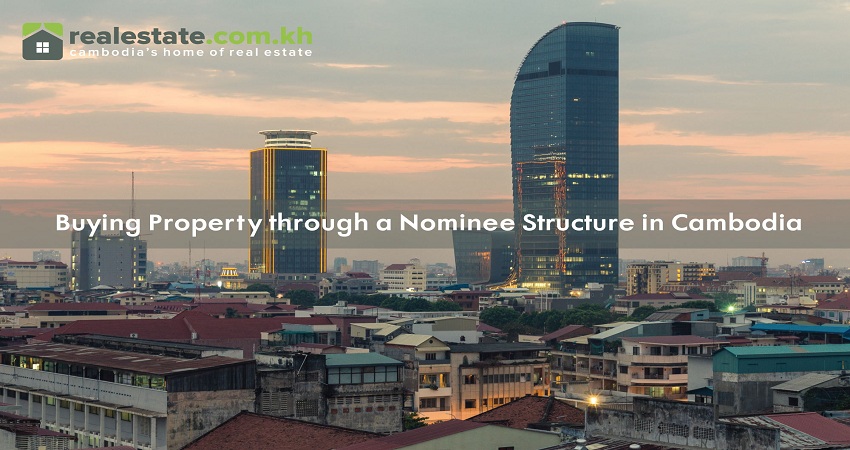Report Summary
Ruessei Kaev’s landed housing market grew remarkably within the preceding five-year period from 2012 to 2016, with an average of 1,600 new housing units launched into the market each year. Well over 2,800 units were completed in 2016, and it is projected that well over 3,000 additional units will be finished off and ready for prospective occupants by 2017.
Fortunately, only 14 percent of the launched units are awaiting total completion recorded as of today, whereas 17 percent are still listed on the market inventory. In sum, albeit a slight market slowdown since the end of 2015, housing market stimuli initiated by developers has come to ignite the demand engine again, giving rise to a ‘slightly’ positive trend expected to continue over the course of 2017.
Ruessei Kaev District
Ruessei Kaev district (Khan Ruessei Kaev or Khmer: ខណ្ឌឬស្សីកែវ) is one of Phnom Penh’s 12 districts and administratively subdivided into 6 communes (Sangkat or សង្កាត់), namely Chrang Chamreh Ti Muoy, Chrang Chamreh Ti Pir, Kilomaetr Lekh Prammuoy, Ruessei Kaev, Svay Pak, and Tuol Sangkae. The district lies north and northeast of the prominent central business districts of Doun Penh and Tuol Kouk, having easy and quick access to the central city of Phnom Penh. As combined, Ruessei Kaev district is currently home to an estimated number of 180,000 residents.
Introduction

The rapid growth in population, increasing traffic pressure, and rising property prices in the inner city center have all quickened the increasing rate of urban expansion to many different suburban parts of the capital, including many parts of Ruessei Kaev district. Thus, housing demand started to exist, especially in the suburbs, as a way to accommodate this rapid growing population.
Landed housing market began in Phnom Penh since 2002, when a few of supplies were on the market and some of the housing construction work was started for a few hundred housing units in some parts of the capital. Afterwards, Ruessei Kaev, one of Phnom Penh’s 12 districts, saw a gradual increase in cluster landed housing market since 2003, when Borey Rith development was first launched in Tuol Sangkae commune (in Ruessei Kaev district), supplying a rough number of 700 linkhouse units.
Housing Market Share

As of today, Ruessei Kaev district is home to a cumulative supply of 12,200 landed housing units (with 86 percent complete, while some under construction), clustering in different communes of the district.
Recorded as of 2016, Chrang Chamreh Ti Muoy shares 21 percent (about 2,544 units) of the total cumulative housing market supply; Chrang Chamreh Ti Pir, 4 percent (465 units); Kilomaetr Lekh Prammuoy, 25 percent (3,085 units); Ruessei Kaev commune, the largest market, up to 29 percent (3,574 units); Svay Pak, 5 percent (597 units); and Tuol Sangkae, 16 percent (2,004 units).
Market Share by Project
 Across Ruessei Kaev district, a number of cluster landed housing projects have been positioned to offer residential options for home buyers from different parts of the capital.
Across Ruessei Kaev district, a number of cluster landed housing projects have been positioned to offer residential options for home buyers from different parts of the capital.
The market share dominance as of 2016 was Borey Vimean Phnom Penh by Ly Hour Development Co., Ltd., sharing up to 16 percent (1,977 units, 90 percent of which were complete) of the total cumulative supply.
Borey Peng Huoth, Borey New World, and Borey Rith shared the second largest market in the district, up to 9.1 percent, 8.9 percent, and 8.4 percent (1,120 units, 1,102 units, and 1,035 units, respectively). Nevertheless, there were also many other projects with fewer than 400 units, collectively sharing up to 39 percent (4,787 units, 84 of which were totally complete up to the date of reporting) of the total cumulative market supply.
Housing Development, Completion, Sale
Performance by Commune
Among the six communes of Ruessei Kaev district, Chrang Chamreh Ti Muoy had 1,398 units completed, 247 units nearing completion, and 899 others still under construction. Overall, the commune achieved up to 94 percent of all units sold, outperforming the other communes within the district.
Chrang Chamreh Ti Pir fetched a relatively small market share, having only 465 units in total supply, with 94 units totally complete, 148 units nearing completion and 223 others under construction. About 51 percent of the housing units there had been sold out.
Kilomaetr Lekh Prammuoy held a relatively large market stake within the district, having a total supply of 3,085 units, with 1,375 units totally complete, 593 units nearing completion, and 1,072 others under construction. About 72 percent of the total housing supply there had been sold.
Ruessei Kaev commune took the largest share within the district, having up to 3,574 units of the total supply, with 2,537 units totally complete, 291 units nearing completion, and 733 others under construction. About 80 percent of the total housing supply had been sold out.
Svay Pak had a total of 597 units supplied, without yet any units complete by then, while 303 nearing completion, and 294 others under construction. About 78 percent of all the units there had been sold out.Last, Tuol Sangkae held a relatively large market stake, having a total market supply of 2,004 units, with 1,850 units totally complete, 28 units nearing completion, and 111 others still under construction. Above all, all of the units there had been sold at presale stage.
Supply and Completion by Year

Cluster housing market has been around in Ruessei Kaev district since 2003, with first construction launch of about 739 units by Borey Rith in Tuol Sangkae, a commune immediately adjacent to Boeng Kak Ti Muoy of Tuol Kouk district to the southwest and Srah Chak of Doun Penh district to the south.
Afterwards the construction work of cluster landed housing started gradually until 2007, when the supply jumped, bringing 1,275 of new off-plan units into the market. But global economic downturn slowed down the speed of housing demand, yet most of landed housing construction work was not delayed at the time. Until 2012, the economy started to show sign of recovery, and housing market supply across the capital started to pick up again, but this time it was stronger than it used to be during the preceding nine years.
In 2012, site work began for the construction of 2,218 units, and in 2013 some additional construction work was launched, bringing 1,859 of new off-plan units into the market, with a few hundred housing units completed each year then.

Despite the decline of new supply within the district, construction completion started to grow gradually; and 2016 was the most remarkable year, when 2,827 housing units of all types were totally completed. Further, by 2017, it is projected based on the data obtained from developers that an additional figure of 3,383 units will be finished and ready for buyers to move in.
Nevertheless, market supply within the district has started to show sign of slowing down because 2016 and 2017 have seen no sign of new housing supply, even though it is too early to predict.
Chrang Chamreh Ti Muoy

Chrang Chamreh Ti Muoy saw the first housing development project in 2012, when construction work started for 546 units of the first out of 5 phases of Borey Vimean Phnom Penh by Ly Hour Development Co., Ltd. In 2013, two other housing projects were launched construction work for 1,321 units, the majority of which were shared by Borey Peng Huoth (the Star Premier).
The trend of the new supply slowed down following those preceding years, except for housing completion which started to jump high in 2015 (with 892 units totally complete), and onto 2017 it is projected that a figure of 1,146 units will be finished that year.
Kilomaetr Lekh Prammuoy
 Kilomaetr Lekh Prammuoy hosted up to 25 percent, or 3,085 of the total cumulative housing units supplied into the market, within Ruessei Kaev district.
Kilomaetr Lekh Prammuoy hosted up to 25 percent, or 3,085 of the total cumulative housing units supplied into the market, within Ruessei Kaev district.

The market supply first started in 2006, with construction work begun for 189 units and finished in 2007. During the economic crisis, there was no further housing supply until 2012, when 1,207 units were added to the housing stock and construction work. Then the market went quiet for a few years until the new supply hit the market again in 2015. That year, construction work started for 1,317 units, offering new presale supply into the market. 2016 saw a small number of new entries to the construction work, yet the figure of housing project completion hopped on the horizon, having totally finished off 1,465 units for buyers to move in.
Ruessei Kaev (Commune)

Ruessei Kaev commune fetched the largest housing market share of the district. The supply began to exist in 2005 from a small base. In 2007, a few projects with 504 units, including one in the area so-called Stad Chas (meaning Old Stadium), were added to the housing stock and launched for construction work. Despite in a small number, the supply went steadily almost every year since then, but the completion was remarkable in 2009 (647 units finished), 2014 (651 units finished), and 2016 (821 units finished). Further, based on the data obtained from the developers, 2017 is projected to see another completion of 654 units.
Tuol Sangkae
Tuol Sangkae took a share of 16 percent of the cluster landed housing market in Ruessei Kaev district. The supply grew strongly but abruptly over the course of the last decade, though all construction projects there were able to be completed before and during the 2008-global economic downturn. And it seemed there was no major entry into the market since 2009 until 2015, when 139 units were launched and slated to be finished in 2016.
Market Supply by Housing Types
Cumulative Market Supply
Across Ruessei Kaev district, the very small percentage of cluster landed housing supply was classified as the purpose-built ‘shophouses’, accounting for only 2.5 percent (290 units), as recorded cumulatively from 2003 to 2016. On the other hand, purpose-built residential link-houses took the largest market share, accounting for 84.8 percent (9,711 units) of the total market supply.
Another housing type classified as ‘semi-detached houses’ held the market stake of 9.5 percent (1,083 units), while ‘single detached houses’ accounted for only 3.2 percent (369 units).

Supply Launched in 2016
New housing market supply launched in 2016 across Ruessei Kaev district was collectively 1,174 units, but the majority of them were link-houses, accounting for 96.7 percent (1,135 units).
Shophouses accounted for 1.1 percent (13 units) of the new launches, while semi-detached houses accounted for 2.2 percent (26 units) the same year.

Houses were listed on average at US$195,700 per units and averagely sold at US$178,800 per units, while single-detached houses were listed on average at US$643,000 and averagely sold at US$595,500 per units.
Market Share by Price Range
Cluster landed housing market in Ruessei Kaev district offered different sets of prices, depending on location, housing type, and the quality.

Practically, there has not been housing supply with pricing about or less than US$25,000 per unit, but those with prices above and up to US$50,000 per unit shared 9.7 percent of the total current supply.
Housing units with prices between more than US$50,000 to US$100,000 per unit accounted for 30.6 percent. And above all, it was up to 41.9 percent of the total housing market supply with pricing between more than US$100,000 to US$200,000 per unit.
Housing units with prices between above US$200,000 to US$300,000 per unit accounted for 6.5 percent, and those with prices above US$300,000 to US$500,000 per units as combined accounted for 4.8 percent.
However, there was still a market for housing units with prices of more than US$500,000 to US$1,800,000 per units, as combined accounting for 6.5 percent of the total market share.
Housing Size
Sizes of housing units vary across the district, depending on housing types and development schemes of the housing projects.
However, based on common market supply within the district of Ruessei Kaev, average size of land for shophouses was between 90 sq.m and 160 sqm, while cover-up area (built-up) of between 60 sqm and 110 sqm. The total building area (also GBA) could range from 160 sqm to 200 sqm.
Linkhouses are usually designed for residential purposes, and thus the sizes are usually smaller than shophouses. In practice, average land size for linkhouses was between 80 sqm and 180 sqm, with average cover-up area ranging from 60 sqm to 80 sqm and average GBA of 100 sqm to 180 sqm.
Semi-detached houses are designed with wider width but relative depth (or length) if compared to linkhouses. For average land size, semi-detached houses were usually spared with 160 sqm to 300 sqm, depending on sub-types and specific designs of the houses. Nevertheless, the built-up area was between 80 sqm and 150 sqm, while the total building area could range from 230 sqm to 300 sqm.
Above all, single-detached houses are larger and more expensive than another other housing types in the market. Average land size reserved for a single detached house could range from 350 sqm to 780 sqm, while its over-up area could be between 160 sqm and 280 sqm. And GBA could range from 470 sqm to 600 sqm.
Housing Market Outlook
Cluster landed housing market in Ruessei Kaev district grew strongly within the past-five-year period, with average launches of new 1,600 units into the market every year between 2012 and 2016, while about 2,800 and 3,380 units will be finished by 2016 and 2017, respectively.
Both sales and construction work performed well recently, with current completion of 86 percent compared all units launched for construction so far. Achieved sales rate was up to 83 percent, meaning only 17 percent still on the market inventory. Despite a slight slowdown since late 2015, market absorption was relatively good within recent years, and this trend still continues to grow well in the next following year, given the overall favorable performance of cluster landed housing market within the district.
The continued growth was thanks to housing market stimuli (such as minimal or zero down payment schemes and other very flexible installment options, to name a few) initiated by developers across the capital’s housing market in the midst of 2016 has also helped bolster the demand and keep the market growth from slowing down.Regarding take-up rate, the majority of the finished housing units are occupied, though relocation of residents to take up the finished housing projects may take some time, about 3 to 6 years on average. Still, speculative purchases of housing units in primary market will still continue to leave some of finished housing units empty due to slower secondary demand than the rate of housing completion, especially in 2016 and onto 2017.
This research report was a production of V Trust Appraisal.
Find property in Khan Ruessei Kaev on Realestate.com.kh!







Comments